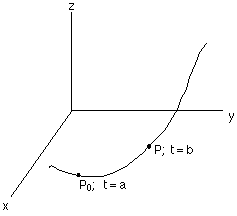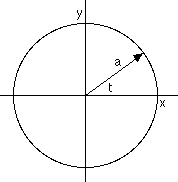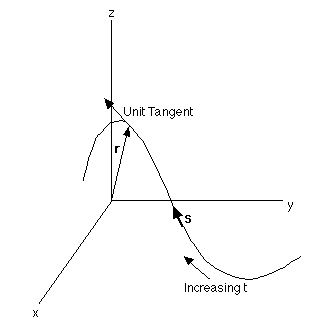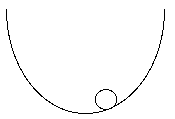Properties of Curves
What happens if we're dealing with a curve with a velocity of constant
magnitude?
|v(t)| = v(t) .
v(t) = C
Differentiating by the Product Rule:
(dv/dt).v + v.(dv/dt) = 0
2 * (dv/dt).v = 0
Since, (dv/dt) = a(t),
v.a = 0
A velocity of constant magnitude is always perpendicular to the acceleration.
Distance Along a Curve
 
Example 1:
The Perimeter of a Circle:
 x = a cos(t); y = a
sin(t) x = a cos(t); y = a
sin(t)
R = a cos t i + a sin t j
v = -a sin t i + a cos t j
|v| = a

L= 2a*pi
Example 2:
Perimeter of an Ellipse:
 x = a cos(t);
y = b sin(t) x = a cos(t);
y = b sin(t)
R = a cos t i + b sin t j
v = -a sin t i + b cos t j


This form of integral is known as the elliptic integral. The elliptic integral has
no elementary solutions, and thus the perimeter of an ellipse must be found
on a case by case basis, using numerical techniques.
Tangents

The unit tangent can be found by:
T = v(t) / |v(t)|
Also, (dR/ds) = (dR/dt) * (dt/ds) =
v(t) / |v(t)| = T
Example:
Tangents of an Ellipse:

From above:
v = -a sin t i + b cos t j

T = v(t) / |v(t)|
At P, t=0 and => T = j
At Q, t=pi/2 and => T = -i
Curvature
Curvature is normally represented by the Greek Symbol Kappa, but I'll use a
capital K here. Similarly, the radius of curvature is represented by a
Greek rho, I'll use a lowercase r.
_________ K=0, r is Infinite
 K=1/a,
r=a K=1/a,
r=a
 At P, K is infinite and r=0. At P, K is infinite and r=0.
The concept of curvature comes from fitting a circle tangent to the curve
in at the point of question. When the circle fits just right, the radius
of the circle is defined as the radius of curvature, r, and 1/r is the
curvature, K.

For any curve, the curvature can be calculated using the following formula:
K = |(dT/ds)| = (|v x a|)/|v|^3
For a proof of the above equation, see Thomas & Finney, Calculus, 8th Edition, p 792.
Notes Created by Lawrence C. Weintraub on 2/25/95
Edited by Milos Borojevic on 3/4/95
Send Comments using the feedback page
|